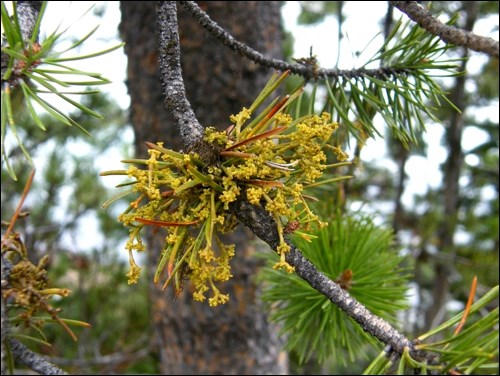From long ago to today, there has always been some fascination with mistletoe. The tradition of hanging mistletoe in the house goes back in time to the ancient Druids. It is believed it has mystical powers that will both bring good luck to the house and ensure that it is free of evil spirits. The mystical power mistletoe has been awarded is likely due to the fact that, when affected deciduous trees have dropped their leaves, it becomes very noticeable with its evergreen tendencies.
There is much folklore surrounding mistletoe. It has been one of the most magical, mysterious and sacred plants of European folklore. Powers of mistletoe include the ability to bestow life and fertility, a powerful aphrodisiac and protection against poison.
The mistletoe of the sacred oak was especially sacred to the ancient Celtic Druids. On the sixth night of the moon, white-robed Druid priests would cut the oak mistletoe with a golden sickle. This ritual was later to symbolize the emasculation of the old king by his successor. It was gathered at both mid-summer and winter solstices, and our tradition of using mistletoe during the Christmas season is a leftover of the Druid and other pre-Christmas traditions.
We can blame Norse mythology for the roots of kissing under the mistletoe. They believed that mistletoe was a sign of love and friendship. The original custom in England was that a berry was picked from the sprig of mistletoe before the person could be kissed. When all the berries were gone, there was no more kissing!
The American or oak mistletoe (Phorandendron serotinum) is a parasitic plant that will grow only in deciduous trees like laurel oaks, sycamores, elms and hackberries from Kansas to New Jersey. This parasitic plant actually will root into the wood of a tree and make a connection with the growing ring of the host. Mistletoe will make its own food but relies on the host for water and nutrients. Plants really are amazing!
Mistletoe is generally spread from birds eating the seeds, and then making deposits that land on suitable host trees. The built-in fertilizer aids in ensuring the mistletoe gets off to a fine start. On the Prairies and in British Columbia, a dwarf mistletoe (Arcethobium spp.) is a more virile member of this family. It has an amazing reproductive technique where coil-shaped cells in the fruit store water and build up pressure over time. Usually around Labour Day the fruit explodes, shooting the seeds up to 20 metres away. We like to call it a water pump seed ejection system of sorts. These dwarf mistletoe have resulted in the destruction of many stands of commercial timber.
The word mistletoe comes from two Anglo Saxon words — “mistel,” which means dung and “tan,” which means twig or stick. So I guess you could translate mistletoe as turd on a twig. Well, so much for the romantic side of mistletoe!
It is important to take care with mistletoe. Between 1985 and 1992, United States poison control centres reported more than 1,500 cases of accidental poisoning of children and pets. Wash your hands well with soap and warm water after handling mistletoe. If you are pruning mistletoe for holiday decor, ensure you take the necessary safety precautions including head and eye protection.
From all of us at the Saskatoon School of Horticulture, we wish you a happy and healthy holiday season.
— Hanbidge is a horticulturist with the Saskatoon School of Horticulture and can be reached at 306-931-GROW(4769); by email at growyourfuture@gmail.com or check out our website at saskhort.com.



